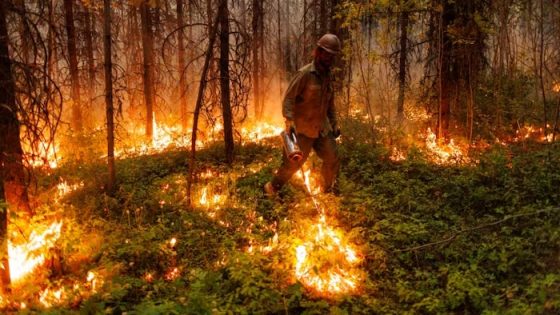Assahafa.com
The federal government says Canada could face another destructive wildfire season because of an unusually warm winter, widespread drought conditions and a forecast of above-normal temperatures in the months ahead.
Officials said during a technical briefing Wednesday that more dry, hot weather is expected this spring and summer, putting much of the country at greater risk of wildfires.
Several regions, including southern Quebec, eastern Ontario and Western Canada, have higher than usual likelihood of fire in April. Risks extend into May and through the summer, though officials stressed much depends on the level of precipitation during this period.
“It is impossible to predict the summer that lies ahead of us, but what is clear is that wildfires will represent a significant challenge for Canada into the future as the impacts of climate change continue to intensify. And the costs to Canadians are growing every single year,” said Harjit Sajjan, the minister of emergency preparedness.
Drought conditions, lower than usual snowpack
Last year was Canada’s worst wildfire season on record, based on a number of metrics, including the total area burned.
The winter months did not bring much relief.
Already, more than 70 fires are burning, primarily in northern British Columbia, northern Alberta and the Northwest Territories, officials said.
What we can learn from Canada’s record wildfire season, as a new one approaches
Spring is here — after Canada’s warmest winter on record
Many of those are holdover fires that have been smouldering since last season.
Dry conditions and unusually low levels of snowpack across much of the country have again made the landscape more susceptible to wildfire, officials said.
“With the heat and dryness across the country we can expect that the wildfire season will start sooner, and end later and potentially be more explosive,” Sajjan said.
A government map of the current drought situation shows that much of the country is experiencing “abnormally dry” conditions.
The worst conditions — exceptional and extreme drought conditions — are in parts of southern Alberta, central and northern B.C. and southern N.W.T.
Canada experienced its warmest winter on record — with the three months of December to February being 5.2 C warmer than the norm since Canada began keeping records in 1948, according to David Phillips, senior climatologist with Environment and Climate Change Canada.
Resources under strain
Last year’s wildfires put a strain on resources. In total, 5,500 firefighters from outside Canada were brought in to help with the fires.
Natural Resources Minister Jonathan Wilkinson said the government is in talks with other countries to better share resources to fight wildfires, and is training more than 600 new firefighters.
“Wildfires have always occurred across Canada — what is new is their frequency and their intensity,” he said.
“The science is clear the root cause of this is climate change. That is why Canada has one of the most comprehensive climate plans in the world and why we are continuing to move forward on it every day.”
The federal government also announced it plans to increase the tax credit available to volunteer firefighters and search-and-rescue volunteers in the upcoming budget, a change that had been pushed for by the NDP.
The government said the move targets rural communities, where firefighters are most often volunteers and they are confronting increasingly more frequent wildfires due to climate change.
The tax credit will increase from $3,000 to $6,000 for 2024 and subsequent tax years, saving volunteer firefighters up to $900 per year.
With this year’s wildfire season arriving across Canada, Jason Woodbury, chief of the Miscouche, P.E.I., fire department, wants people to be proactive to keep their homes and properties safe. As he tells CBC’s Sheehan Desjardins, there are simple actions people can take to reduce their risks from any type of blaze.
Source: cbc














